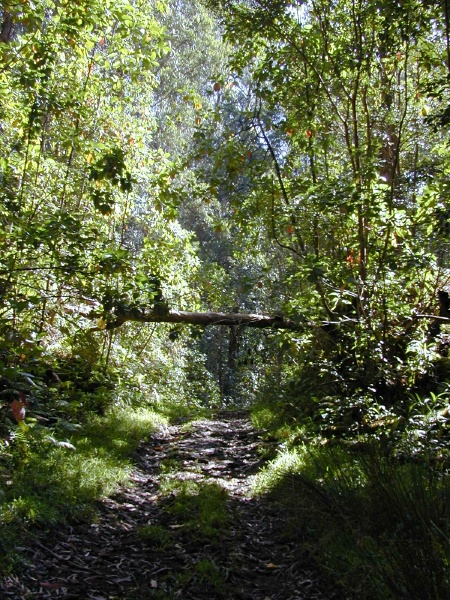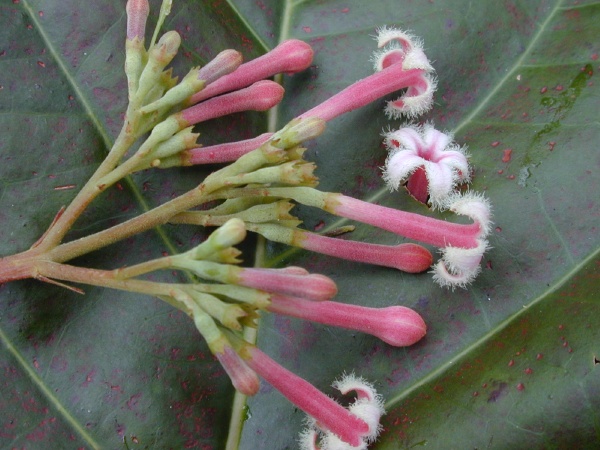Classification
Let's start back at the way beginning of things. Where did the name Cinchona pubescens come from?
Carl Linnaeus saw the drawings of the plant which were made by the French naturalist and explorer Charles Marie de la Condamine. Linnaeus named the plant Cinchona in honor of the Countess of Chinchon whom was the wife of the Count of Cinchon, the Spanish ruler of Peru at the time. The plant also had a nickname around that time period. Linnaeus named the plant in the 18th century and nearing the end of the 17th century, the plant was identified with the Jesuit’s and was known as “Jesuit’s Bark.”
So, that takes care of where Cinchona originated, but what about the word pubescens? The word pubescens in the Latin language can be translated to "downy" or "hairy" in relevance to the hairy surface of the plant. In the upper picture, hair-like structures are growing on the petals of the flowers.
The other common names of Cinchona pubescens
include:
quinine tree, red cinchona,
quina, red
quinine tree, kinakina, China bark, Fever Tree,
Peruvian bark, quina-quina, calisaya bark

The breakdown of Cinchona pubescens...
Domain-Eukarya
Kingdom-Plantae
Phylum-Magnoliophyta
Class-Magnoliopsida
Order-Rubiales
Family-Rubiaceae
Genus-Cinchona
Species-Cinchona
pubescens
Domain-Eukarya
All of the members of this domain have a true nucleus, a plasma
membrane, and membrane-bound organelles.
Kingdom-Plantae
Cinchona pubescens
is a member of this kingdom because
it is multicellular, its cells are organized into tissues and
have cell walls, and it obtains nutrients by photosynthesis.
Below is a phylogenetic tree that I recreated of the three domains based on molecular data analysis. The domain and kingdom of Cinchona pubescens are both in red.

To compare C. pubescens to other organisms in the Plantae kingdom, visit Castor Bean as well as China Rose.
Phylum-Magnoliophyta
Members of this phylum are known as the "flowering
plants." In this phylum, leaves are usually broad and have
advanced venation patterns, flowers are produced, pollen grains
are used to move the sperm nucleus from one flower to another,
many different pollination methods exist which can include:
water, wind, or a variety of animals.
Two other angiosperms to take a look at are Foxglove and Broad-Leaf Peppermint Gum.
Class-Magnoliopsida
This class is more commonly known as the Dicotyledons or the "dicots."
Characteristics of this class include: two cotyledons,
net-like veins, a ring-like pattern of vascular tissue, one main
root, three openings on pollen grains, and floral organs in
multiples of three or five.
I recreated a phylogenetic tree of the land plants from the kingdom Plantae. The tree is based on morphological analysis and the groups that Cinchona pubescens belongs to are highlighted in red.

Be sure to explore more dicots at MultipleOrganisms.net! A few of them include Sweet Orange and Apple Guava.
Order-Rubiales
The Rubiales order is known to have leaves that are opposite of
one another, and an inferior compound ovary.
The Noni is also a member of this order, go check it out!
Family-Rubiaceae
The Rubiaceae family is also more informally known as "The
Coffee Family." It is a very diverse family made up of
tropical trees, shrubs, and plants.
Genus-Cinchona
This genus is made up of trees that grow on an average of up to
15-20 meters in height, have white, pink, or yellow flowers, and
all have originated from the eastern slopes of the Amazonian
area of the Andes.
The tree below shows the relation of Cinchona to the other genus groups in the family Rubiaceae. The tree is based on molecular data analysis.
Species-Cinchona pubescens
Cinchona pubescens
can be a small to
rather large tree that can reach up to about 10 meters in
height. When the bark of the tree is cut, it usually turns
a reddish color. The trees have oval to oblong leaves with
obvious veins, the flowers are sweet-smelling and can range from
white to pink, and each flower has its own stalk attached to the
branch.
 Next
go to
Habitat to find out where it is you may find the
quinine tree growing.
Next
go to
Habitat to find out where it is you may find the
quinine tree growing.
To go back to the homepage click Home.

